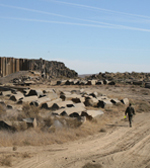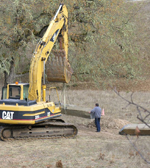
basalt formations
The stone sculpture and environmental sculptures are made from hard stones, either granite or basalt. The granites were formed millions of years ago through heat and pressure. The basalt is the result of slow cooling lava flows which erupted 8-10 million years ago. The stone comes from all over the world. The raw material comes in quarry blocks, glacial boulders and columns. Regardless of its shape, we search for the highest quality material that carves well and holds enduring finishes.
A commissioned sculpture begins begins with a client and site visit. By the time the sculpture is designed, fabricated and installed, hundreds to thousands of hours of highly-skilled craftsmanship will be applied to complete the finished artwork. Cully Ewing, my experienced studio assistant for over ten years, helps in most phases of the sculpting and fabrication process.
I begin by taking inspiration from the site to develop concept design sketches, presentation drawings and scale models of the design. Then I present the design options to the client. Upon approval the fabrication process begins, and working drawings and engineering are completed.
The first step is a quarry visit to select the raw material for the specific design. Special quarry operations to obtain the best material are done when projects call for it. The material is loaded on semi trailer trucks and transported to my Seattle studio and off-loaded with the industrial equipment at the shop.
Then, we break down the bulk stone into pieces which are larger than, but close to, the size of the stones in the design. This is done by sawing them with the large diamond saw in the shop or by drilling and splitting in the traditional methods. The rough blocks are then set up in the shop and moved into a variety of positions. Lines are drawn on the blocks, and they go back to the bridge saw for more saw work.
When the saw work is complete, the carving begins. This is a process where we combine old and new technologies: the latest and most current diamond-tooling equipment helps us remove material to reach the shape. Then we use traditional stone tools and techniques that have been used for centuries to produce shapes that look hand-formed and surfaces that are textured and tooled. This is where all of the shapes are made.



Pieces are continually set up and fit together until the shapes, the joints, and the surfaces are carved to exactly where we want them to be.
When the carving is complete, the finishing begins. The stone is first finish-grinded with diamond cup wheels. When this grinding and shape refinement is completed, the polishing begins. During this process we use diamond polishing wheels, which begin at a coarse grit and graduate to a super-fine grit. This creates a natural stone polish. Eight complete sequences of hand- and machine-polishing then follow to reach a complete polish. Using cranes and forklifts, we carefully load and pack the completed sculpture on semi-trucks for delivery to the site for installation.
Under my direction, the footings and other needed construction have been completed at the site. We carefully rig and hoist the completed pieces into place, sometimes adjusting each piece many times before it is exactly where it goes. The completed sculpture is cleaned, and any other construction around it is finished and it is open to enjoy.

stone carving

hoisting a sculpture into place

